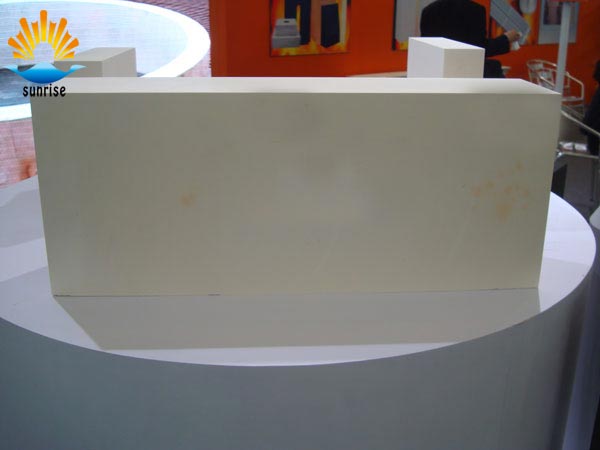SEARCH
when you need our product,simply enter the name of the product you are looking for to continue.
Refractory Knowledge
- Which refractory materials are acidic products?
- Five Advantages of Ceramic Fiber Board
- Lightweight firebrick ten functions
- Manufacture of Magnesium and Aluminum Brick
- Ceramic Fiber Blanket Not Equal To Ceramic Fiber Felt
- High Quality Ceramic Fiber Blankets For Sale are Popular All
- Phone:0086-371-63838939
- Email:sales@sunriserefr.com
- Office Address: No.36 Fengchan Road Of Zhengzhou, Henan, China (Mainland)
Contact Us
News & Events
Glass kilns with refractory materials
Date:2017-06-16 15:21 | From:Zhengzhou Sunrise Refractory | Author:admin
This article briefly introduces the glass kiln and glass kiln refractory materials, respectively, describe the various parts of the refractories used, combined with the actual situation of different refractory materials and the use of the situation. And introduced the float glass production process, compared to the float produced by the nature of glass and flat glass. Finally, the development trend of refractory materials for glass kilns. Keywords: glass kiln; refractory; float glass; development trend Modern glass production technology compared with the traditional process has a qualitative leap, towards a higher efficiency, lower energy consumption, better product quality in the direction of continuous development. Kiln as the core of glass production equipment, its technical level is also progressing, widely used to improve the combustion strength, strengthen the heat transfer effect, reduce heat loss, reduce the product and environmental pollution and other new technologies. The technological progress of the kiln requires a variety of quality refractory materials as a guarantee condition, requiring refractories to withstand higher temperatures, more abrupt temperature changes, more intense chemical erosion, more severe stress damage, and only supporting the use of multiple varieties High-quality refractory materials, kiln new technology, energy efficient, low pollution and other advantages can be achieved. High-quality refractory materials for modern high-temperature technology is not only consumable materials, but also to achieve high-temperature new technology necessary functional materials. Over the past decade, China's glass industry with refractory materials have made great progress, integrated in the large-scale float glass kiln kiln, from 3 to 4 years to 5 to 8 years, and all the materials to achieve the localization, greatly Narrowing the gap with the advanced level of foreign countries, for the glass industry with the future development of refractories, laid a solid foundation. But with the further development of the glass industry and foreign advanced level compared to the situation, there are still many problems to be solved. 1. Glass melting furnace Overview Glass melting furnace is made of glass for thermal equipment, usually made of refractory material. The use of fuel chemical energy, electricity or other energy to generate heat, resulting in controllable high temperature environment (distribution and atmosphere), so that the glass batch in which the heat transfer, mass transfer and momentum transfer process to complete the physical and chemical changes, Melting, clarification, homogenization and cooling stages, the production of a certain amount and quality of glass.
The melting process of glass
The melting process of glass
In accordance with the glass formula mixed with a good material, after the formation of high temperature heating process of glass, known as the melting of glass. The purpose of melting is to be uniform, pure, transparent and suitable for forming glass. The melting of glass is a very complicated process, which includes a series of physical, chemical, physical phenomena and reactions. These phenomena and the results of the reaction, so that the mechanical mixture of various raw materials into a complex melt, that is, glass. The physical, chemical and physical phenomena of the various compounding materials in the process of forming the glass are substantially the same. The changes that occur during heating are as follows (1) Physical process: including the heating and adsorption of the batch (2) chemical processes: including solid-phase reactions, decomposition of various salts, hydrates, and the like. (2) chemical processes, including solid phase reactions, decomposition of various salts, hydrates (3) physical and chemical processes: including the formation of eutectic, the mutual dissolution of components or between the products, the glass and the furnace, and the dissolution of the composition, The interaction between the gas medium, the interaction of the glass liquid and the refractory material, and the interaction of the glass liquid and the mixed gas therein. The melting process is divided into five stages (1) silicate forming stage (2) glass forming stage (3) glass clarification stage (4) glass liquid homogenization stage (5) glass cooling stage must be noted that the above five The role of the stage and the changing mechanism have their own characteristics, different from each other, but close contact with each other. In the actual melting process there is no obvious boundaries at all stages, not necessarily in order, some stages may be simultaneously or part of the same time.


If you have any needs our help or are interested in our products, you can click online advisorychat with us online, or call our customer service telephone: 0086-0371-63838939. We will sincerely serve for you!
